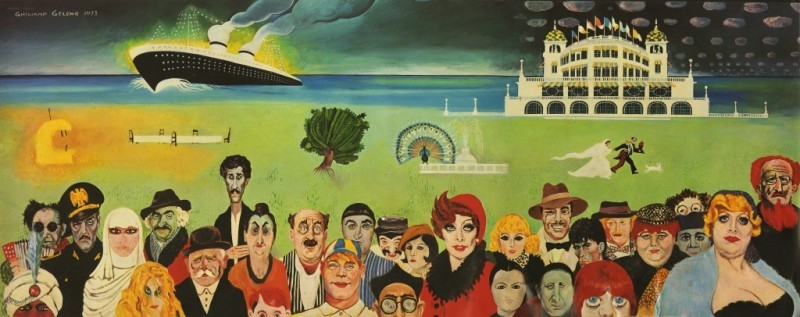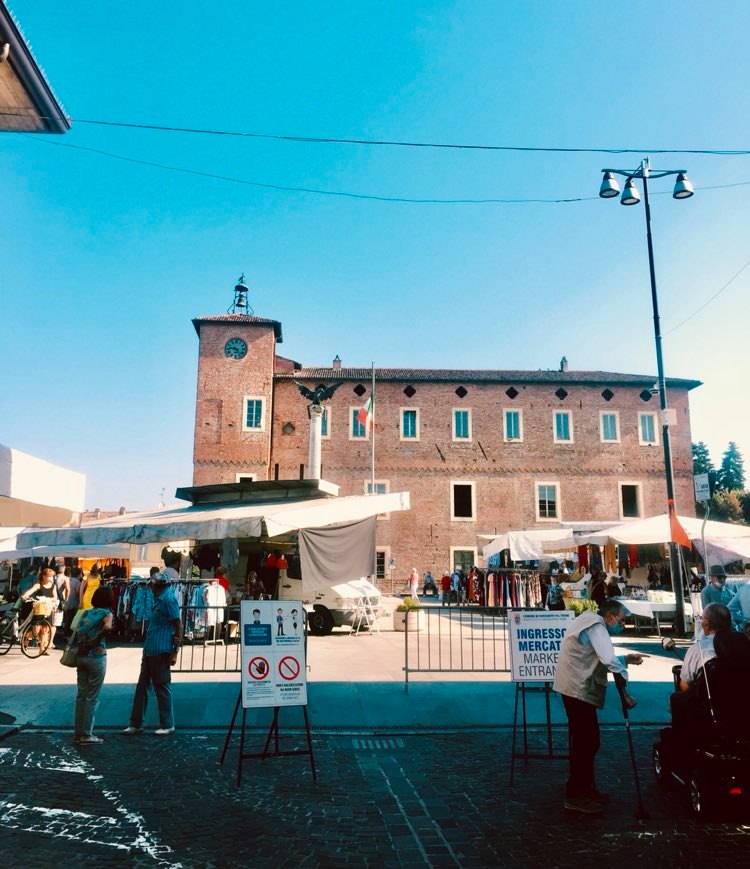
For as long as I’ve lived, my family’s life has been dictated by the rhythms and the rituals of the market. Until the pandemic redefined this piece of Italian history, congregating in the piazza del mercato to buy produce, fish, flowers, underwear, cheese and cleaning supplies – or just to chat and to observe – was a fixed appointment that took place weekly. While the markets in my home-country closed and the squares emptied due to the pandemic, markets in the UK – from Borough Market in London to local farmers’ markets – remained open.
I was born in a family of ambulanti. Un ambulante is one who walks, who moves, who doesn’t have a fixed domicile. One who exercises their commerce in fairs and markets with an itinerant stall, not in a shop.
The word reminds me of the circus, with its red and yellow tent appearing in town suddenly. As children we wondered where their journey would take them next, or whether the circus existed in a magical limbo before returning to us, one year on, with the laminated fliers near the school.
To be born and raised in a small town means being connected to the fabric of that town, to its characters and its events, to its shops and to its traditions. The town takes from you and is absorbed by you. Most importantly, the town never really leaves you.
This came to me as a revelation while watching Federico Fellini’s Amarcord (1973) for the first time as an Italian expat in London. Fellini and I were born on different sides of the dual region that is Emilia-Romagna: he was romagnolo, I am emiliana. Two identities which differ in the food served at Sunday lunch and in the dialect spoken by the elderly on market day, but which converge when it comes to the attachment to one’s town.
Amarcord is Fellini’s semi-autobiographical film which follows the story of Titta, a teenager growing up in the town of Borgo San Giuliano, near Rimini, in 1930s fascist Italy. The film is a chorus of eccentric characters, immersed in local folklore and dialectal expressions. The title itself comes from a dialectal phrase in Romagnolo: a m’arcôrd (“I remember”).
The film ends with a wedding celebration: La Gradisca, the character who embodies the femininity of Romagna and the town’s desire, is getting married and leaving town. The wedding banquet is bittersweet, and one question lingers:
“Ma come farai a stare lontana dal borgo?”
“How will you cope with being away from the town?”

The characters know, deep down, the town will never leave la Gradisca.
We find a similar parallel in pop culture in the characters of Rory and Lorelai Gilmore in Gilmore Girls. Although Rory leaves Stars Hollow, the town and its circus never leave her. She finds them, unmoved, upon her return. Although the series’ Netflix revival was criticised by critics and fans alike for not retaining the original spirit of the show, I find a nod and homage to Fellini’s Amarcord in its often absurd magic realism. A place of playful fantasy, of masks and caricatures. Aren’t we, after all, always remembering the ideal of a place rather than the place itself?
In conversations, I’ve often drawn parallels of the absurd between Borgonovo Val Tidone, my hometown, and Stars Hollow. Both have characters whose social lives are regulated by the town’s events and both have calendars of eccentric festivities planned by a bunch of Taylors (the town selectman in Gilmore Girls). Stars Hollow has the Festival of Living Art and a Renaissance Fair, while Borgonovo has the Fiera dell’Angelo and the Festa d’la Chisöla, both hosted in the Italian agora: la piazza del mercato.
My family sells bags and leather goods, items known in Italian as pelletteria. My grandfather used to build the umbrellas that cover and protect each stall, with hooks hanging from the top to better display the items on sale. He and my grandmother ran one stall, while his brother and his wife ran the other. My grandmother specialised in selling hats, my great-aunt specialised in slogans. I like to think of them with the words of Maurizio Melucci, former assessor to Tourism and Commerce for the region Emilia-Romagna: “Across the centuries merchants were the promoters of cultural exchanges, of connections, but they were also spectators and protagonists of profound changes. They were the bearers of news, even when a little bit ‘romanticised’, as if they were storytellers.”1
As a child, I spent a few weeks at my grandmother’s every summer. This meant I would travel with the family daily, to wherever the market day was. We followed an itinerary which has remained unchanged since my mother was a teenager:
Monday – rest
Tuesday – Stradella
Wednesday – Piacenza
Thursday – Castel San Giovanni
Friday – Codogno
Saturday – Piacenza
Sunday – Castel San Giovanni
The markets in Piacenza and Castel San Giovanni were my favourites. Piacenza was beautiful with not one but two squares, bustling with chatter, dialect, bicycles. My family had one stall in each square: Piazza Duomo and Piazza Cavalli. However, the market in Castello was the most familiar, being in my family’s town. I could walk from the market to the house and back in a few minutes, and my cousins would take me for a cappuccino and croissant before business began. I mostly sat on the side of the open van and observed the town living before my eyes. It was a carnival and I adored it.
Moving to London in 2012, I was drawn to the smells of the street food markets: the excitement for the new. Still, for years after moving, I reserved the purchases of new underwear, pyjamas, slippers and clothes for my visits to Italy, making sure my trip included a Monday – Borgonovo’s giorno di mercato.
In 2020, with the pandemic significantly increasing distances, I longed for a weekly market day. I longed for the local, the familiar, the first-name basis kind of market.
As September 2020 brought about the hope for new beginnings, my local park announced a farmers’ market to be held every Saturday. For the first time in months, I felt a new ritual coming about and one that involved leaving the house, tote bags in hand.
The first stall my boyfriend and I stopped at was called Dorothy’s Deli. We built our salad boxes, one chicken, one salmon. I asked Dorothy to add one courgette fritter to mine for good measure, and she seasoned everything with a generous splash of her homemade vegan mayo. We took the food home to eat, wary of standing close to many people, the act of eating requiring one to be unmasked. On the way back, all I could think about was the feeling of washing my hands and eating the fritter with them, food that wouldn’t taste like the hand sanitiser in my pocket.
One Saturday, to our surprise, we walked to the market and saw L’Ubriaco’s stall, the drunk cheese business we both knew and loved from Borough Market. This discovery has led to long conversations with its owner, Max, who introduces us to a new cheese every two weeks while sharing tales of cheese, wine and Italy. Our favourite is called Gugu Blu: a semi soft cow’s milk blue cheese refined with Zibibbo, a Sicilian dessert wine, and coated with figs and walnuts. I love that L’Ubriaco has its origins in Veneto, the region my grandfather was from. The market remains a social connector whose soul lies in its storytellers. As we say in Italy: “Tutto il mondo è paese” (The whole world is a town).
The market is a reassuring signpost for the end of each week. It has helped me keep track of time in days which feel like the clones of all the ones that came before. It’s reassuring to know that Max’s stall is on every other week, that Dorothy is there every Saturday, that each week there is something new to bring home with excitement, usually in the form of bottles and jars. Sometimes this is hot sauce, sometimes it’s a flavoured vegan mayo (miso and sesame is my current favourite), while some weeks are made simply to observe others’ market rituals behind my mask.
I returned to Italy once in 2020, for my birthday in July. I was one of the lucky ones who could see home and family in the year of the pandemic. I hadn’t spent my birthday in Italy in six years and, coincidentally, it fell on a Monday: giorno di mercato.
I wore a dress and sandals as pearls of sweat started falling on my face in the early hours of the morning. My friend Paola picked me up in front of my mother’s shop and we headed to the market square. We sat outside one of the bars of Via Roma with a coffee and a croissant (my childhood cappuccino had matured into a macchiato). Shop owners stood outside their shops to chat with their neighbours, while the elderly tried to recognise the eyes behind the masks.
We headed to Ciro’s stall, the fishmonger. He was already haggling with the matriarchs of the town. I was going to cook dinner for my family: squid in its ink and shell-on prawns in a cherry tomato, chilli and parsley sauce. Ciro told us he would need time to clean the squid and to do a tour of the market while we waited. It was market day, after all.

20th July 2020
1 Maurizio Melucci, in the preface to Markets and the Challenges of Competition, Quaderni del terziario. Copyright © 2013 Libreria Bonomo Editrice.
Irene, January 2021
